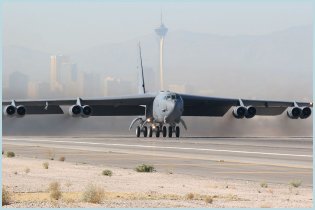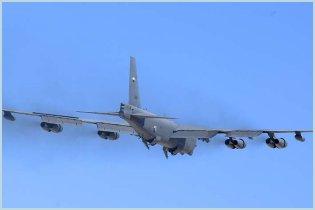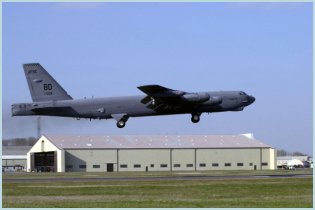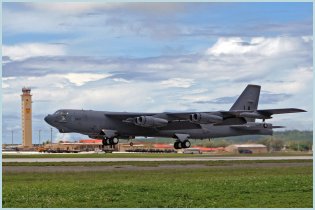B-52H Stratofortress Boeing
| a | ||||||||||||||||||||||
|
Boeing B-52H Stratofortress long-range heavy bomber
|
||||||||||||||||||||||
|
|
||||||||||||||||||||||
 |
||||||||||||||||||||||
|
The B-52H is a long-range, heavy bomber designed and built by Boeing Company (Boeing Military Airplane Co.), which has continued to provide support and upgrades since the first models. The B-52H strategic bomber is capable of flying at high subsonic speeds at altitudes up to 15 km. It can carry nuclear or precision guided conventional ordnance with worldwide precision navigation capability. In a conventional conflict, the B-52 can perform strategic attack, close-air support, air interdiction, offensive counter-air and maritime operations.
For more than 40 years B-52 strategic bombers have been the backbone of the manned strategic bomber force for the United States. The B-52A first flew in 1954, and the B model entered service in 1955. A total of 744 B-52s were built. The first of 102 B-52H's was delivered to Strategic Air Command in May 1961. The H model can carry up to 20 air launched cruise missiles. In addition, it can carry the conventional cruise missile that was launched in several contingencies during the 1990s, starting with Operation Desert Storm and culminating with Operation Iraqi Freedom. In 2001, the B-52H contributed to the success in Operation Enduring Freedom, providing the ability to loiter high above the battlefield and provide close air support through the use of precision guided munitions. Only the H model is still in the Air Force inventory and is assigned to the 5th Bomb Wing at Minot AFB, N.D., and the 2nd Bomb Wing at Barksdale AFB, La., which fall under Air Force Global Strike Command. The aircraft is also assigned to the Air Force Reserve Command's 307th Bomb Wing at Barksdale AFB. The USAF still maintain 58 B-52H Stratofortress bombers in service, and 18 others aircraft remain in reserve. |
||||||||||||||||||||||
| Main Variants | ||||||||||||||||||||||
|
-B-52A: Only three of the first production version, the B-52A, were built, all loaned to Boeing for flight testing.
-NB-52A: carrying an X-15 -B-52B/RB-52B: was the first version to enter service with the USAF on 29 June 1955 with the 93rd Bombardment Wing at Castle AFB in California.This version included minor changes to engines and avionics, enabling an extra 12,000 pounds of thrust using water injection. -NB-52B: was a B-52B converted to an X-15 launch platform. -B-52C: B-52C's fuel capacity (and range) was increased to 41,700 US gallons by adding larger 3000 US gallon underwing fuel tanks. The gross weight was increased by 30,000 pounds (13,605 kg) to 450,000 pounds. A new fire control system, the MD-9, was introduced on this model. -RB-52C: was the designation initially given to B-52Cs fitted for reconnaissance duties in a similar manner to RB-52Bs. As all 35 B-52Cs could be fitted with the reconnaissance pod, the RB-52C designation was little used and was quickly abandoned. -B-52D: was a dedicated long-range bomber without a reconnaissance option. The Big Belly modifications allowed the B-52D to carry heavy loads of conventional bombs for carpet bombing over Vietnam, while the Rivet Rambler modification added the Phase V ECM systems, which was better than the systems used on most later B-52s. Because of these upgrades and its long range capabilities, the D model was used more extensively in Vietnam than any other model. -B-52E: It received an updated avionics and bombing navigational system, which was eventually debugged and included on following models. -B-52F: was given J57-P-43W engines with a larger capacity water injection system to provide greater thrust than previous models. -B-52G: was proposed to extend the B-52's service life during delays in the B-58 Hustler program. At first, a radical redesign was envisioned with a completely new wing and Pratt & Whitney J75 engines. This was rejected to avoid slowdowns in production, although a large number of changes were implemented. The most significant of these was the brand-new "wet" wing with integral fuel tanks which considerably increased the fuel capacity; gross aircraft weight went up by 38,000 pounds (17,235 kg) compared with prior variants. In addition, a pair of 700 US gallon (2,650 L) external fuel tanks was fitted under the wings. In this model, the traditional ailerons were eliminated. Instead, spoilers provided roll control. The tail fin was shortened by 8 feet (2.4 m), water injection system capacity was increased to 1,200 US gallons (4,540 L), and the nose radome was enlarged. The tail gunner manning the 4 .50 caliber machine guns (quad mounted in a remote controlled tail turret on the G-model (ASG-15), the guns were later removed from all operational aircraft) was relocated to the main cockpit and was provided with an ejection seat. Dubbed the "Battle Station" concept, the offensive crew (pilot and copilot on the upper deck and the two bombing navigation system operators on the lower deck) faced forward, while the defensive crew (tail gunner and ECM operator) on the upper deck faced aft. |
||||||||||||||||||||||
| Technical Data | ||||||||||||||||||||||
| Design | ||||||||||||||||||||||
|
The B-52 shared many technological similarities with the preceding Boeing B-47 Stratojet strategic bomber. The two aircraft used the same basic design, such as swept wings and podded jet engines, and the cabin included the crew ejection systems. The B-52H had the same crew and structural changes as the B-52G. The B-52H variant is the only still operational. A total of 102 B-52Hs were built. The crew is composed of an aircraft commander, a pilot, a radar navigator, a navigator and an electronic warfare officer.
The B-52H has a length of 48.5 m, a height of 12.4 m and a wingspan of 56.4 m. It features a wing area of 370 m² (4,000 sq ft). |
||||||||||||||||||||||
|
Propulsion
|
||||||||||||||||||||||
|
The most significant upgrade of the B-52H was the switch to TF33-P-3 turbofan engines which, despite the initial reliability problems (corrected by 1964 under the Hot Fan program), offered considerably better performance and fuel economy than the J57 turbojets. The B-52H has eight Pratt & Whitney TF33-P-3 turbofan engines, each providing more than 17,000lb of thrust. The aircraft has ten internal plus two external fuel tanks with a capacity of over 181,000l, which give an unrefuelled range of more than 8,600 miles. The operational range with one air refuelling is 7,500nm. There has been increasing support for an upgrade programme to re-engine the B-52H. Boeing has received a contract to study the options which include proposals for either four or eight new engines. New turbofan engines increase the unrefuelled range and provide the aircraft with the capability to strike a target located anywhere on earth from a CONUS (continental US) base with a single refuelling.
In September 2006, the B-52 bomber became one of the first US military aircraft to fly using alternative fuel. It took off from Edwards Air Force Base with a 50/50 blend of Fischer-Tropsch process (FT) synthetic fuel and conventional JP-8 jet fuel, which burned in two of the eight engines. This program is part of the Department of Defense Assured Fuel Initiative, which aims to reduce crude oil usage and obtain half of its aviation fuel from alternative sources by 2016. On 8 August 2007, Air Force Secretary Michael Wynne certified the B-52H as fully approved to use the FT blend. |
||||||||||||||||||||||
|
Avionics
|
||||||||||||||||||||||
|
All B-52s are equipped with an electro-optical viewing system that uses platinum silicide forward-looking infrared and high resolution low-light-level television sensors to augment targeting, battle assessment, and flight safety, thus further improving its combat ability and low-level flight capability. Under the nose section are the steerable chin turrets for the AN/ASQ-151 electro-optical viewing system (EVS), which consists of the Raytheon AN/AAQ-6 forward-looking infrared (FLIR) in the starboard turret and Northrop Grumman AN/AVQ-22 low-light-level television camera (LLTV) in the port turret.
Pilots have night vision goggle (NVG) capability to enhance their vision during night operations; providing greater safety and increasing the pilot's ability to visually clear terrain, avoid threats and see other aircraft in a covert/lights-out environment. On-going modifications incorporate the global positioning system, external and internal weapon data bus upgrades and a full array of advance weapons currently under development. A recent modification is the addition of an advanced targeting pod, which offers infrared and electro-optical tracking and laser designation of stationary and moving targets. Additionally, an electronic data link and global messaging system has been added and can be used in conjunction with, or independent of, the advanced targeting pod. |
||||||||||||||||||||||
| Armement | ||||||||||||||||||||||
|
The B-52 is capable of dropping or launching the widest array of weapons in the U.S. inventory. This includes gravity bombs, cluster bombs, precision guided missiles and joint direct attack munitions.
 This includes: - Conventional: MK82 (500 lb) (51), MK84 (2000 lb) (18), MK117 (750 lb) (51), BDU-48 (17), AGM-84 Harpoon missiles (8), AGM-142 Raptor missiles (4), AGM-86C conventional air-launched cruise missiles (CALCM) (20), joint stand-off weapons (JSOW) (12), joint direct-attack munitions (JDAM) (12), wind-corrected munitions dispenser (WCMD) (16), GBU-10 (8 to 10), GBU-12 (10), GBU-28 (4), MK56 (20), MK62 (51), MK63 (18), MK65 (18). - Nuclear: AGM-129 advanced cruise missiles (ACMS) (12), AGM-86A air-launched cruise missiles (ALCM) (20), bomb (8). A 20 mm M61 Vulcan cannon originally was mounted in a remote controlled tail turret on the H-model, but was removed from all current operational aircraft in 1991. |
||||||||||||||||||||||
| Specifications | ||||||||||||||||||||||
|
||||||||||||||||||||||
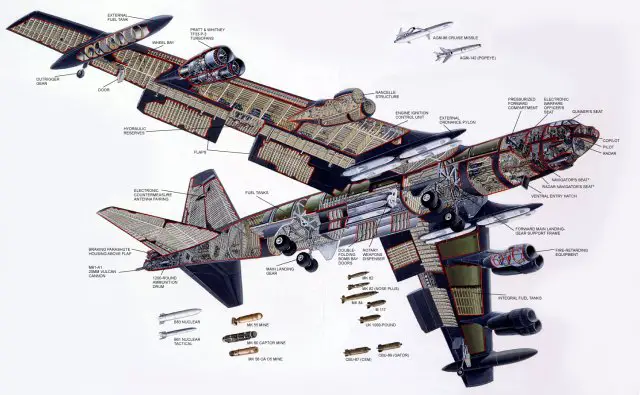 |
||||||||||||||||||||||
|
||||||||||||||||||||||



























